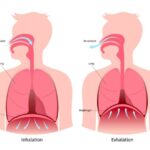The Basics:
The Temporomandibular Joint, or TMJ, is the most used joint in the body. It is estimated that one uses the TMJ 1500-2000x/day. Approximately 50-75% of people will suffer from at least one symptom of TMJ dysfunction in their lifetime (pain, clicking, etc.). Everyone has two TMJs, a right and a left.
The TMJ consists of the mobile mandible and the relatively fixed temporal bone. Between these two bones is a disc. Ideally, this disc enhances joint stability and mobility. There are times when the disc stops functioning properly and may cause pain and impair the joint mobility. For example, it may limit mouth opening. Surrounding the joints are the ‘muscles of mastication’, or chewing muscles. These include the masseter, temporalis, and pterygoids. In cases of overuse or misuse, these muscles can become dysfunctional and painful. Examples of overuse or misuse include clenching, grinding, and excessive gum chewing.

It is not uncommon for people who are suffering from TMJ pain or dysfunction to also complain about other symptoms such as headaches, neck pain, dizziness, and tinnitus (buzzing or ringing in the ears).
Conservative Management:
A thorough evaluation is necessary in order to establish a personalized rehabilitation protocol. However, there are a number of things that are generally beneficial and can be implemented immediately by anyone suffering from TMJ pain or dysfunction.
Practice Good Posture
Overall Posture: Good posture is all about balance. How you sit or stand has an impact on your neck and TMJ. In sitting, if you slouch from your pelvis and back, you must then look up in order to continue looking straight forward– try this. Looking up puts pressure on the nerves of the upper neck which can lead to neck pain, headaches, and TMJ pain. Looking up also changes the resting alignment of the TMJ– and not for the better. So, sit in a balanced position (not too slouched and not too tall), allowing your neck to rest in a more neutral position.
For more information regarding posture optimization, see:
Guide to Optimal Sitting Posture
Oral Posture: When not speaking, chewing, or otherwise using your mouth, your tongue should rest on the roof of your mouth with the tip of the tongue resting along the ridge behind your front teeth. Your lips should be together, and your teeth should either be in light contact or not touching. If you tend to grind and clench, it is best for you to keep your teeth apart. You should breathe through your nose, not your mouth.
Sleeping Posture: If you are a stomach sleeper, STOP sleeping on your stomach. This puts too much pressure/tension on the neck and the TMJ. Instead, sleep on your back (and hug a pillow to your stomach if you need to feel like you are sleeping on your stomach). If sleeping on your side, make sure that the pillow you use is thick enough (but not too thick) to support your neck in a neutral position. Your head should not be tilted up or down but should lie flat.


Modify Your Habits. Control What You Can.
- ’Don’t pick the scab’. You can’t get better if you keep getting worse. If there are habits, movements, activities, etc. that you are doing that aggravate your TMJ, you need to stop or modify those activities.
- Stop clenching and grinding: you may or may not be able to control whether or not you clench and grind during the night, but you can control this during the day.
- Stop chewing gum: repetitive, excessive chewing may be a cause of your pain.
- Don’t bite your nails: this is a good rule for general hygiene as well.
- Try a soft food diet: Minimize hard foods and foods that require a lot of chewing such as red meat. It may also help to spend more time chewing with the uninvolved side.
- Try to relax: Stress plays a huge role in perpetuating pain and inflammation, and this is particularly true of the TMJ. Meditate, exercise, or do something that you enjoy to limit the amount of stress you feel. Research shows that cognitive behavioral therapy is beneficial for people suffering from TMJ pain (and other pain conditions). Your thoughts influence the outcome!
Try These 2 Exercises
The first exercise’s focus is to improve the mobility and coordination of your TMJ. The second exercise is meant to take stress off of the muscles of the TMJ. If your pain is muscular in nature, this should make a difference.
1. Mouth opening with the tongue on the roof of the mouth:
The purpose of this exercise is to improve the coordination and muscle control of the TMJ (coordinated people hurt less).
How to:
Start with your mouth closed and your tongue resting on the roof of your mouth along the ridge behind your front teeth. Keep the tongue on the roof of your mouth and slowly open your mouth, following a trajectory in which you are attempting to move your chin down and towards your neck, as opposed to straight down.
Watch yourself in a mirror. There should not be any asymmetry while performing this exercise. If you notice your jaw deviating to the left or to the right, stop the exercise.
Otherwise, perform 25 repetitions 1x/day.

Correct Positioning 
Incorrect Positioning
2. Resisted Mouth Opening:
The purpose of this exercise is to create a relaxation of the muscles that may be a source of TMJ pain.
How to: Start with your mouth closed and your tongue resting on the roof of your mouth. Place a fist under your chin, and gently begin trying to open your mouth against the resistance of your fist. The tongue must stay on the roof of the mouth, and you should not push harder than about 50% your maximum. The goal is no movement or opening. Hold this for 10 seconds and then relax. If this results in a decrease in pain and symptoms, repeat as needed throughout the day.

Other Conservative Management Strategies Include:
- Trial of anti-inflammatories (Ibuprofen, Naproxen):
- These should be taken under a physician’s care and discontinued if no benefits are seen within 7 days or if side effects ensue.
- Mouth Guards:
- Mouth guards are fabricated by dentists who specialize in treatment of the TMJ. In general mouth guards are intended to either stabilize the TMJ to improve the relationship of the temporal bone and the mandible OR to reposition the mandible by bringing it forward (this helps to, among other things, decrease stress on the joint and open the airway).
- Generic mouth guards can be purchased over-the-counter at a drug store. These may work to protect your teeth from wear and tear if you happen to clench and grind. However, they will not stop you from clenching/grinding, and may not have much of an effect on pain.
I hope that you see some benefit in implementing these strategies. These strategies are not a substitute for evaluation and treatment. Many patients suffering from TMJ pain have contributing problems related to the cervical spine, tongue tie, Airway dysfunction, amongst other things. Please seek care from an IPA Physio therapist if your pain does not resolve with these strategies.
If you would like more information about our practice, would like to schedule an evaluation, or have any questions– please contact us and let us know.
More valuable information about how to maintain and optimize your health and wellness can be found here:
Health and Wellness: What Every Patient Should Know









